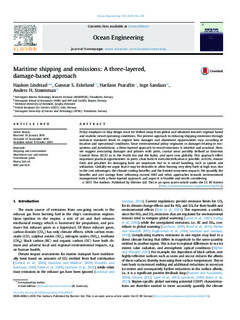| dc.contributor.author | Lindstad, Haakon | |
| dc.contributor.author | Eskeland, Gunnar | |
| dc.contributor.author | Psaraftis, Harilaos | |
| dc.contributor.author | Sandaas, Inge | |
| dc.contributor.author | Strømman, Anders Hammer | |
| dc.date.accessioned | 2016-01-05T11:45:52Z | |
| dc.date.accessioned | 2016-09-02T08:14:31Z | |
| dc.date.available | 2016-01-05T11:45:52Z | |
| dc.date.available | 2016-09-02T08:14:31Z | |
| dc.date.issued | 2015 | |
| dc.identifier.citation | Ocean Engineering 2015, 110(B):94-101 | nb_NO |
| dc.identifier.issn | 0029-8018 | |
| dc.identifier.uri | http://hdl.handle.net/11250/2403737 | |
| dc.description | -This is an open access article under the CC BY license | nb_NO |
| dc.description.abstract | Policy emphasis in ship design must be shifted away from global and idealized towards regional based and realistic vessel operating conditions. The present approach to reducing shipping emissions through technical standards tends to neglect how damages and abatement opportunities vary according to location and operational conditions. Since environmental policy originates in damages relating to ecosystems and jurisdictions, a three-layered approach to vessel emissions is intuitive and practical. Here, we suggest associating damages and policies with ports, coastal areas possibly defined as Emission Control Areas (ECA) as in in North Sea and the Baltic, and open seas globally. This approach offers important practical opportunities: in ports, clean fuels or even electrification is possible; in ECAs, cleaner fuels and penalties for damaging fuels are important, but so is vessel handling, such as speeds and utilization. Globally we argue that it may be desirable to allow burning very dirty fuels at high seas, due to the cost advantages, the climate cooling benefits, and the limited ecosystem impacts. We quantify the benefits and cost savings from reforming current IMO and other approaches towards environmental management with a three-layered approach, and argue it is feasible and worth considering. | nb_NO |
| dc.language.iso | eng | nb_NO |
| dc.publisher | Elsevier | nb_NO |
| dc.rights | Navngivelse-Ikkekommersiell-IngenBearbeidelse 3.0 Norge | * |
| dc.rights.uri | http://creativecommons.org/licenses/by-nc-nd/3.0/no/ | * |
| dc.subject | shipping and the environment | nb_NO |
| dc.subject | abatement cost and options | nb_NO |
| dc.subject | greenhouse gases | nb_NO |
| dc.subject | heavy fuel oil | nb_NO |
| dc.subject | IMO and ECA | nb_NO |
| dc.title | Maritime Shipping and Emissions: A three-layered, damage based approach | nb_NO |
| dc.type | Journal article | nb_NO |
| dc.type | Peer reviewed | nb_NO |
| dc.date.updated | 2016-01-05T11:45:52Z | |
| dc.rights.holder | ©2015 The Authors. Published by Elsevier Ltd. | nb_NO |
| dc.source.pagenumber | 94-101 | nb_NO |
| dc.source.volume | 110 | nb_NO |
| dc.source.journal | Ocean Engineering | nb_NO |
| dc.identifier.doi | 10.1016/j.oceaneng.2015.09.029 | |
| dc.identifier.cristin | 1278363 | |
| dc.relation.project | Norges forskningsråd: 239113 | nb_NO |

